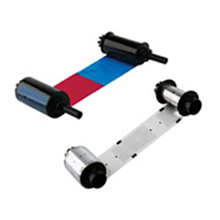If you're new to the ID card printing scene – specifically with dye sublimation printers –

you may have heard the terms "overlays" and "laminates" in your research. If you're wondering whether one term is synonymous with the other, the simple answer is "no."
The two options do have similarities; however, there's a difference between overlays and laminates.
The easiest way to think of it is this:
- Overlay = protects the printed images and text on a card
- Laminate = shields the card itself from wear and tear
Overlays
The ribbons used in dye sublimation printers contain a thin, clear overlay panel (also called the "O" panel). The overlay on this panel is automatically applied to cards during the printing process and can help prevent the ultraviolet (UV) fading on images.
Here are a few distinguishing features about overlays:
- Although they do not provide added durability or longevity to cards, overlays offer a thin layer of protection to the print and images.
- They do not provide added durability to cards.
- Standard PVC cards can be used in tandem with overlays, because no additional heat is used during the printing process.
Laminates
During the standard printing process with dye sublimation and reverse transfer printers, laminate is applied to the top of a printed card. It's a thin layer of film that's available in a variety of thicknesses.
Some laminates cover the entire surface of a card, while "patch" laminates cover most of a card, leaving a small non-laminated border around a card's outer edge.
Here's how laminates differ from overlays:
- They greatly enhance a card's durability to protect it from wear and fading.
- Laminates are optimal for high-usage cards like those swiped each day through a reader.
- They're available in clear and with standard or custom holographic designs embedded in the actual laminate material for added visual security.
- Cards using a holographic laminate prevent tampering and counterfeiting.
- Composite PET cards are necessary because of the heat used during the printing process.
 Industry experts estimate that the cost of replacing a non-laminated card is about 40% more expensive than the up-front cost of a laminating printer. Additionally, a laminated card is 15 times more durable than a non-laminated card.
Industry experts estimate that the cost of replacing a non-laminated card is about 40% more expensive than the up-front cost of a laminating printer. Additionally, a laminated card is 15 times more durable than a non-laminated card.
| To help determine whether an overlay or laminate is the right choice for your card issuance program, call an ID Professional at (800) 321-4405 x2 or chat now. We’re here to help! |
 you may have heard the terms "overlays" and "laminates" in your research. If you're wondering whether one term is synonymous with the other, the simple answer is "no."
The two options do have similarities; however, there's a difference between overlays and laminates.
The easiest way to think of it is this:
you may have heard the terms "overlays" and "laminates" in your research. If you're wondering whether one term is synonymous with the other, the simple answer is "no."
The two options do have similarities; however, there's a difference between overlays and laminates.
The easiest way to think of it is this:
 Industry experts estimate that the cost of replacing a non-laminated card is about 40% more expensive than the up-front cost of a laminating printer. Additionally, a laminated card is 15 times more durable than a non-laminated card.
Industry experts estimate that the cost of replacing a non-laminated card is about 40% more expensive than the up-front cost of a laminating printer. Additionally, a laminated card is 15 times more durable than a non-laminated card.
